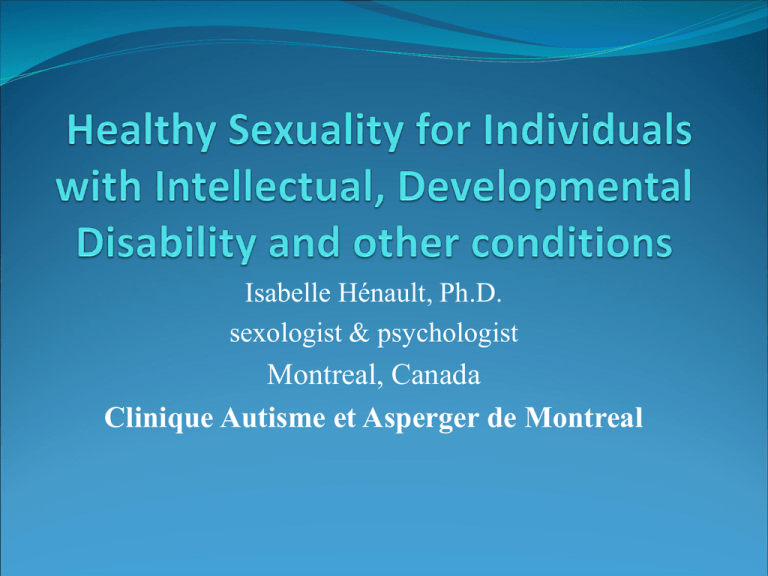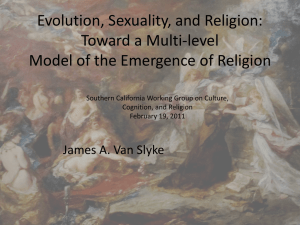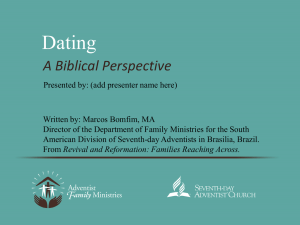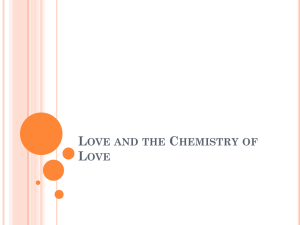
Isabelle Hénault, Ph.D.
sexologist & psychologist
Montreal, Canada
Clinique Autisme et Asperger de Montreal
Definition of sexuality
Few research & clinical attention
Normal part of development and life
Complexity of sexuality: more than behaviours!
Intellectual and Developmental
Disability Profile
Social skills: free of social rules
Communication abilities: verbal and non verbal
Theory of Mind: different ways of thinking?
Emotions: detecting, reading, expressing
Sensory issues
Impulsive behaviours
Co-morbidity (other diagnosis)
Fears related to sexuality
Not being able to provide correct answer to a
question
STDs & AIDS
Unwanted pregnancy
Unions, couples, marriage
Sexual exploitation
Judgment of others
Higher level of sexual interest
Issues of development
Sexual behaviours: self-stimulation, exploring
sexuality
Frustrations and inappropriate behaviours
Gender identity & role definition:
flexibility, conflict, confusion
Social imitation: context, consent
Issues of development
Interpretation of emotions: black & white!
Interpersonal relationships: couples, empathy,
intimacy. Confusion & anxiety, disappointment
Sexual drive, desire, curiosity
Factors influencing social and
sexual development (Griffiths, 1999)
Information
Basic knowledge
Experiences
Social support
Limitations of the environment
Gender segregation
Social network
Rules
Sex education
Factors influencing social and
sexual development
Intimacy
Interests and limits
Private and public setting
Exploration
Medication
Secondary effects
Synergic effects
Infections
Monitored
Factors influencing social and
sexual development
Rights and attitudes
Stereotypes
Permissive attitude or protective attitude?
Inappropriate behaviors
Selection of partner
Restricted choices
Natural choices
Expanding social circle
Sexual history
Sexual abuse: repetition, trauma
Lack of knowledge and experiences
Inappropriate behaviors
Sensory issues: hypersensitivity, hyposensitivity of
tactile sense: vulvodynia, irritations, compulsivity
Social attention
Misunderstanding the environment
Deficit in expression (needs, verbal emotional)
Lack of stimulation or activities
Inappropriate behaviors
Overwhelming demands
Organic factors (25% serious health problems) no
complains…
Psychologic/psychiatric condition: dual diagnosis
Depression, anxiety
ADHD
Phobia, OCD, etc.
Puberty
Physiological changes
Hormones levels (testosterone, oestrogen)
Body changes: body hair, sexual function, reactions,
periods, etc.
Psychological changes
Emotions (mood changes,stronger, cycle)
Independence
Curiosity
Interests
Puberty
Friendship & social skills
Skills: communication: verbal & non verbal, social
interactions, sharing
Intensity of relationship
Appropriate: finding a balance
Inappropriate
Love & friendship, intimacy
Puberty
Recognition of abusive/unfriendly relationship
Dangerous relationship
Qualities of a healthy relationship
Sharing
Communication
Pleasure, interest
Respect, communication and much more…
Making Waves Program:
http://www.counselling.net/
Puberty
Self esteem: image
Self confidence: positive experiences
Social network
Finding identity (group, norms, person, sexual)
Isolation
Depression, anxiety, (arrogance 15%)
Aggressive behaviors, self-abusing behaviors
Puberty
Hygiene
Positive & appropriate image
Peer pressure & reactions
Desire to create relationships
Transition period, adjustments
Steps to Good
Hygiene
Body
Face
twice/day
Deodoran
t
Teeth
Twice/day
Clean
clothing
Periods
(change sanitary
pad every 2-4
Hygiene
Monday
Tuesday
Wed.
Thursday
Friday
Saturday
Sunday
AM. P.M.
A.M. P.M.
A.M. P.M.
A.M. P.M.
A.M. P.M.
A.M.
A.M.
P.M.
P.M.
Sex education
Goals:
Better knowledge
Develop own limits and judgement
Decode situations: interpersonal & intimate contexts
Improve social and sexual skills: learn adaptive and
positive behaviours
www.jkp.com
Sociosexual Skills Workshops
www.jkp.com
10-12 weeks, 90 minutes
10 themes
Small groups (4-12)
Adolescents & adults
Questionnaires, games, role-playing, software,
videos, discussions, social stories, group project
www.cheneliere-education.ca
Workshop Themes & Activities
Introduction
1. Love & friendship
2. Physiological changes
3. Sexual relationships
4. Emotions
5. Contraception and prevention of STD and AIDS
Workshop Themes & Activities
6. Sexual orientation
7. Alcohol, drugs and sexuality
8. Sexism and gender roles
9. Sexual abuse and problem behaviours
10. Theory of Mind, communication and intimacy
www.msss.gouv.qc.ca
Free Program
Preventing AIDS and other STDS
through sexuality education for
students with intellectual impairments Compendium of teaching and learning
activities geared to adapted curricula
Government program-free
Gender differences, body parts
Age groups
Private-public
Sexual behaviours
www.msss.gouv.qc.ca
"
.
.
3. Sexual relationships
« My first relationship » video
« Fears » checklist
« Values » game
The Five Senses Activity:
A) Experience the senses?
B) Consequences in relationships?
C) Behaviours concerned?
Emotional sensitivity
“We don’t have emotional skin or protection. We are
exposed, and that is why we hide”. Liliana
The Understanding and Expression of
Affection
Ability to read the signals when
someone expects affection.
Ability to express the appropriate
level of affection.
The Understanding and
Expression of Affection
Affection to repair someone’s feelings.
An immature expression of affection.
A limited vocabulary of expression that may not
include subtle or age appropriate expressions.
Sometimes needing frequent expressions of affection
for reassurance.
“We feel and show affection but not
often enough, and at the wrong
intensity”
Affection?
Why are typical people so obsessed with
expressing reciprocal love and affection?
A hug can be an uncomfortable,
constricting squeeze.
Don’t cry because someone will squeeze
you.
Not comforted by affection to the degree
that neurotypicals expect.
Different Perspective
Intense dislike of public praise that includes words and
gestures of affection.
The capacity for affection, a cup versus a bucket.
Empathy
Different type of empathy
Practical-functional
Not in words or gestures
Compassion for animas
Actions
Empathy
Affection to repair feelings
Frequency of affection
Sensory sensitivity and affection
Aims of the Program
Affection education to ‘de-mystify’ affection.
To understand why people need and enjoy affection.
Explain and encourage appropriate expressions of
affection.
Explain to parents the perspective of the person with
Asperger’s syndrome.
Objectives
1.
Help each child-adolescent discover how expressing
and experiencing affection can improve friendships
and relationships.
2. Help each child-adolescent to identify not only his or
her own comfort and enjoyment range for gestures,
actions and words of affection, but also those of
friends and family members.
3. Improve for each child-adolescent the range of
expressions for liking and loving someone, appropriate
to each relationship and situation.
4. Explain to parents, friends and professionals the
challenges faced by a person with an ASD in reading
the signals that indicate when expressions of affection
are needed and appreciated.
4. Emotions and sexuality
Explore, identify and recognize a range of emotions
Pictures of human faces
Imitation
Mirror
Software-Gaining Face/Mind Reading
Emotions related to sexual realities: body language
Emotions Thermometer
5. Contraception and prevention
Quizz
Importance of condom use
Demonstration on « penile model »
Condom use
10-steps on « penile model »
In fact, what ’s the first step?
6. Sexual orientation
List of myths
Quizz: Am I homophobic?
Video
Discussion
7. Alcohol, drugs and sexuality
Group project: scenario
Positive approach (reinforcement) instead of
reprehensive
Guide on the effects of alcohol and drugs on sexuality
8. Sexism and gender roles
Privacy, boundaries, intimacy
Video: « machos »
Stereotyped relationships and roles
Scenarios and role-playing
9. Sexual abuse and inadequate
behaviours
Intimacy
Consent
Sexual assault
Sexuality and the law
10. Mind-blindness,
communication & intimacy
Social Stories integrating sexuality
Recognize other ’s emotions:
Mind Reading software (Baron-Cohen & coll., 2002)
www.jkp.com
Non verbal skills
Role-play: ToM activities
www.thetransporters.com
www.jkp.com
Relationships
(What to expect in the couple?)
Respect
Accepting the partner ’s imperfections
Constructive criticism
Developing the potential of the couple
Blaming AS
Balance in the couple
Making time
Priority
Schedule management
Spending time together
Relationships
Insecurity
Taking responsibility
Making you feel good: comittment and trust
Dealing with conflict
Compromise
Dividing tasks
Using qualities of each partner
Relationships
Expressing emotions
Gestures, non verbal communication
Decoding the feelings of the partner
Intensity of emotions
Communication
Non verbal (? %)
Avoiding misinterpretations
Coherence
Priority
Video: www.ait.com
5 Safety rules: sexual abuse prevention
Basic rules, behaviours, young teenagers, low to
middle functioning
Videos
www.yai.org Relationship series-3 videos
1. Friendship
2. Boyfriend-girlfriend
3. Sexuality
Videos
Flirting or Stalking?
Making New Friends
Love or Abuse?
www. socialsignalsed.com
Results
1.Improvement of social and sexual skills
Presentation
Conversation/reciprocity
Helping/empathy
Non verbal skills
General knowledge/judgement
Results
2. Reduction of problem behaviours
Isolation (contact, activities, conversation)
Impulsivity
Inapp. sexual behaviours (masturbation, touching)
3. Generalization (3 months measure)
Better knowledge
Interpersonal relationships, friendship
Positive attitude about sexuality
Discussion
Interest and needs from individuals
Demand from parents and professionals
Interesting results
Service curriculum









